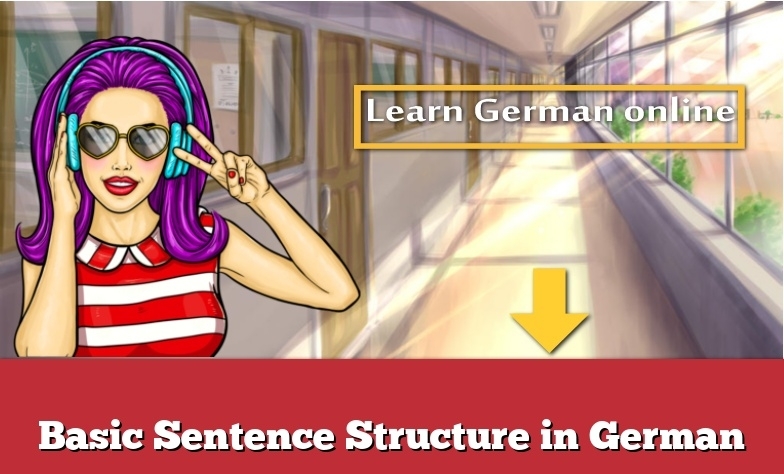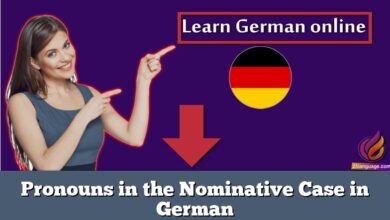Basic Sentence Structure in German

Basic Sentence Structure in Germa.Certainly! Here’s an explanation of basic sentence structure in German, along with its English translation. German sentences typically follow a Subject-Verb-Object (SVO) order, much like English. However, the placement of the verb can change depending on the type of sentence (e.g., main clause, subordinate clause).
| German Sentence Structure | German Example | English Translation |
|---|---|---|
| Subject-Verb-Object | Der Hund jagt die Katze. | The dog chases the cat. |
| Verb-Subject-Object | Jagt der Hund die Katze? | Does the dog chase the cat? |
| Subject-Verb-Complement | Der Apfel ist rot. | The apple is red. |
| Verb-Subject-Complement | Ist der Apfel rot? | Is the apple red? |
| Compound Sentence | Ich kaufe Brot und er isst es. | I buy bread and he eats it. |
- Subject-Verb-Object (SVO): This is the most common structure for declarative sentences in German.
- Verb-Subject-Object (VSO): In questions, the verb often moves to the beginning of the sentence.
- Subject-Verb-Complement: Used in sentences where the verb links the subject to a complement (like adjectives or noun phrases).
- Verb-Subject-Complement: The structure for questions with a linking verb.
- Compound Sentence: Involves multiple clauses, often connected by conjunctions like “und” (and).
Remember, German sentences can become more complex with the addition of modal verbs, subordinate clauses, and various tenses, which may alter the typical word order.
Examples
Sure, I can provide a table with examples of basic sentence structures in German, along with their English translations. This will help illustrate how typical German sentences are formed and how they correspond to English.
| German Grammar Concept | German Example | English Translation |
|---|---|---|
| Simple declarative | Ich lese ein Buch. | I am reading a book. |
| Simple interrogative | Liest du das Buch? | Are you reading the book? |
| Negative sentence | Ich habe kein Geld. | I have no money. |
| Command | Öffne das Fenster! | Open the window! |
| Compound sentence | Ich kaufe Brot, und sie isst Käse. | I buy bread, and she eats cheese. |
| Sentence with modal verb | Ich kann heute nicht kommen. | I cannot come today. |
| Sentence with a subordinate clause | Ich denke, dass er schläft. | I think that he is sleeping. |
These examples cover a range of basic sentence structures in German, from simple statements and questions to more complex sentences involving compound elements and subordinate clauses. German sentence structure can be quite flexible, especially in more complex sentences, but these examples provide a good foundation for understanding the basics.
Sentences
Certainly! Below is a table featuring examples of basic sentence structures in German, accompanied by their English translations. This table should help illustrate the fundamental aspects of constructing sentences in German.
| German Sentence Structure | German Example | English Translation |
|---|---|---|
| Simple Statement | Der Hund schläft. | The dog is sleeping. |
| Yes/No Question | Schläft der Hund? | Is the dog sleeping? |
| Simple Negative | Ich habe kein Auto. | I don’t have a car. |
| Command | Steh auf! | Stand up! |
| Compound Sentence | Ich lese und sie schreibt. | I am reading and she is writing. |
| Question with ‘W’ (Interrogative) | Was liest du? | What are you reading? |
| Subordinate Clause | Ich weiß, dass er schläft. | I know that he is sleeping. |
These sentences cover a range of basic structures, including statements, questions, commands, and compound sentences, giving a good foundation for understanding simple German syntax.
Phrases
Sure, here’s a table with examples of basic sentence structures in German, along with their English translations. This table will help in understanding how basic phrases are constructed in German.
| German Sentence Structure | German Example | English Translation |
|---|---|---|
| Subject-Verb-Object | Der Junge spielt Fußball. | The boy plays soccer. |
| Verb-Subject | Hat Maria das Buch gelesen? | Has Maria read the book? |
| Subject-Verb-Adverb | Das Auto fährt schnell. | The car drives fast. |
| Subject-Verb-Adjective | Der Himmel ist blau. | The sky is blue. |
| Compound Sentence | Ich kaufe ein Brot und er isst Käse. | I buy bread and he eats cheese. |
| Verb-Subject-Object | Liest du das Buch? | Are you reading the book? |
| Subject-Verb-Negation | Sie hat kein Geld. | She has no money. |
These examples cover a variety of basic structures, including declarative sentences, questions, and compound sentences. They provide a straightforward way to grasp the fundamentals of German sentence construction.
Comprison
To illustrate the comparison between basic sentence structure and question structure in German, along with their English translations, here is a table:
| Sentence Type | German Structure | German Example | English Translation |
|---|---|---|---|
| Basic Sentence Structure | Subject-Verb-Object (SVO) | Der Hund jagt die Katze. | The dog chases the cat. |
| Question Structure | Verb-Subject-Object (VSO) for Yes/No Questions | Jagt der Hund die Katze? | Does the dog chase the cat? |
| ‘W’ Question Word + Verb-Subject-Object for Information Questions | Was macht der Hund? | What is the dog doing? |
- Basic Sentence Structure: German typically follows the Subject-Verb-Object order for simple declarative sentences, similar to English.
- Question Structure: For yes/no questions, the verb moves to the beginning (Verb-Subject-Object). For questions asking for information, a ‘W’ question word (like “was” for “what”, “wo” for “where”) is placed at the beginning, followed by the verb and subject.
This comparison shows how German rearranges the basic sentence structure to form questions, a common feature in many languages.





























